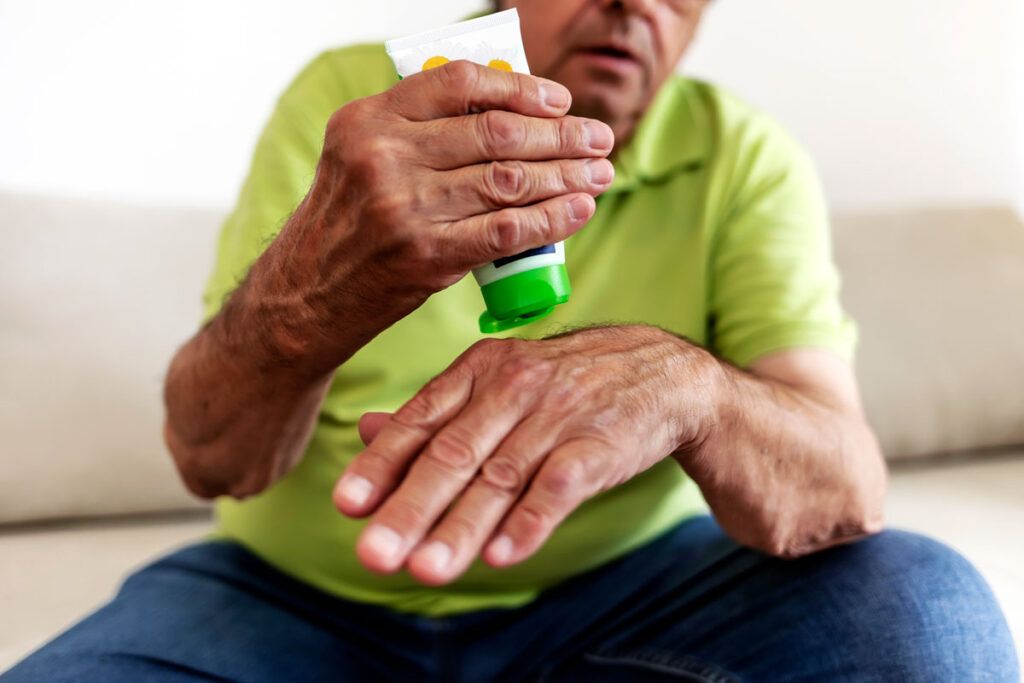Weeping eczema happens when your eczema has blisters with fluid that seeps out. Weeping eczema often occurs because of an infection during a severe stage of the skin condition.
Eczema encompasses skin conditions characterized by inflammation, itchiness, dryness, swelling, and discoloration. About 32 million people in the United States have eczema.
There are different types of eczema, and all of them can become weeping if the affected area has an infection.
Weeping eczema

The term eczema includes several different conditions that make the skin itchy, swollen, inflamed, and discolored. It may appear red in light skin but purple, gray, or brown in dark skin. There are seven types of eczema. If not properly treated, all of them can become weeping eczema.
Weeping eczema happens when eczema reaches a severe state — the affected skin is infected with bacteria or fungus and fills with fluid. The fluid seeps and oozes out of the damaged skin, which led to the name weeping eczema.
These are the types of eczema:
- atopic dermatitis
- contact dermatitis
- neurodermatitis
- dyshidrotic eczema
- nummular eczema
- seborrheic dermatitis
- stasis dermatitis
People can have more than one type of eczema. Eczema is not contagious, and neither is weeping eczema.
Symptoms
Some common symptoms of weeping eczema include:
- open sores and blisters
- skin lesions that seep out fluid that can be clear or yellowish
- itching and burning
- redness
- crusty skin
- pustules that are white or yellowish
If the infection becomes more severe, you may experience more serious symptoms like:
- fever
- fatigue
- flu-like symptoms
- swollen lymph nodes in your armpits, neck, or groin
Talk with a healthcare professional if you have these symptoms.
Causes
The causes for eczema vary, from environmental triggers to genetic factors. Some common triggers for eczema include:
- cigarette smoke
- pet dander
- dust mites
- pollen
- chemicals
- soaps and detergents
- temperature changes, either hot or cold
- a very dry or humid environment
Since weeping eczema happens when your eczema becomes infected, the causes of weeping eczema are the germs that lead to the infection. When eczema becomes severe, and the skin is damaged, bacteria and viruses can enter your body through the open wounds.
Eczema types like dyshidrotic eczema and nummular eczema, which cause very itchy blisters, can become weeping eczema because you are more likely to scratch these areas, causing open lesions where germs can enter and cause an infection.
Some of the most common microorganisms that lead to infection in people with eczema include:
- Bacteria: The most common bacteria that can cause weeping eczema is staph, also known as Staphylococcus aureus.
- Fungi: Candida albicans is a common type of fungus that causes skin infections.
- Viruses: The cold sore virus, or Herpes simplex, can enter your body through the open lesions of severe eczema. This virus can cause an infection that leads to complications like eczema herpeticum, a serious infection that causes blisters and fever.
Treatment
Eczema doesn’t have a cure, but you can manage and reduce symptoms with several treatment options. You can treat weeping eczema with over-the-counter and prescribed medications, as well as home remedies and practices.
Some of the medications that you may use to treat eczema include:
- topical corticosteroids like hydrocortisone (Cortef) and prednisolone (Millipred)
- topical calcineurin inhibitors like pimecrolimus (Elidel) and tacrolimus (Protopic)
- emollients and creams
- oral prednisone
Specific treatment for weeping eczema depends on the cause:
- Bacterial: If the cause is a bacterial infection, you might be given antibiotics like flucloxacillin.
- Viral: If the cause is a virus, you might be given antiviral tablets.
- Fungal: For fungal infections, a doctor might prescribe antifungal medication like miconazole (Micatin).
You may also use some at-home remedies to help alleviate symptoms of weeping eczema. You can:
- Take a bath with oatmeal.
- Use soft and gentle soaps and detergents.
- Wear loose-fitting clothing made of 100% cotton.
- Keep your skin moist with a clean and damp cloth and apply moisturizer.
- Keep your fingernails short.
- Eat anti-inflammatory foods like turmeric.
If you need help covering the cost of medications, the free Optum Perks Discount Card could help you save up to 80% on prescription drugs. Follow the links on drug names for savings on that medication, or search for a specific drug here.
